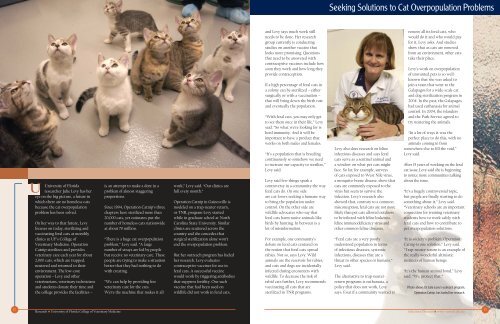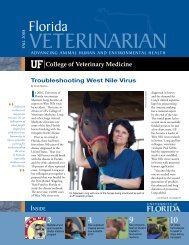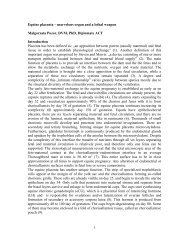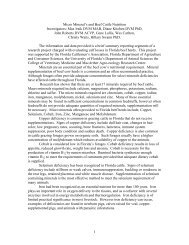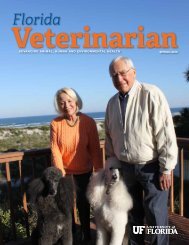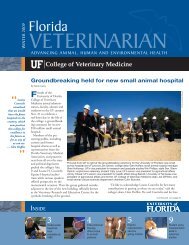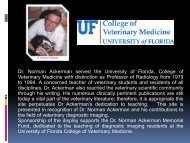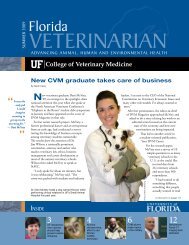College of Veterinary Medicine Research Brochure
College of Veterinary Medicine Research Brochure
College of Veterinary Medicine Research Brochure
- No tags were found...
Create successful ePaper yourself
Turn your PDF publications into a flip-book with our unique Google optimized e-Paper software.
Seeking Solutions to Cat Overpopulation ProblemsUUniversity <strong>of</strong> Floridaresearcher Julie Levy has hereye on the big picture, a future inwhich there are no homeless catsbecause the cat overpopulationproblem has been solved.On her way to that future, Levyfocuses on today, sterilizing andvaccinating feral cats at monthlyclinics at UF’s <strong>College</strong> <strong>of</strong><strong>Veterinary</strong> <strong>Medicine</strong>. OperationCatnip sterilizes and providesveterinary care each year for about2,000 cats, which are trapped,neutered and returned to theirenvironment. The low-costoperation – Levy and otherveterinarians, veterinary techniciansand students donate their time andthe college provides the facilities –is an attempt to make a dent in aproblem <strong>of</strong> almost staggeringproportions.Since 1994, Operation Catnip’s threechapters have sterilized more than20,000 cats, yet estimates put thenumber <strong>of</strong> homeless cats nationwideat about 70 million.“There is a huge cat overpopulationproblem,” Levy said. “A largenumber <strong>of</strong> strays are fed by peoplebut receive no veterinary care. Thesepeople are trying to make a situationbetter that they had nothing to dowith creating.“We can help by providing freeveterinary care for the cats.We’re the machine that makes it allwork,” Levy said. “Our clinics arefull every month.”Operation Catnip in Gainesville ismodeled on a trap-neuter-return,or TNR, program Levy startedwhile in graduate school at NorthCarolina State University. Similarclinics are scattered across thecountry and she concedes thatsurgical sterilization alone won’tend the overpopulation problem.But her outreach program has fueledher research. Levy evaluatescontraceptive vaccines for use inferal cats. A successful vaccinewould work by triggering antibodiesthat suppress fertility. One suchvaccine that had been used onwildlife did not work in feral cats,and Levy says much work stillneeds to be done. Her researchgroup currently is conductingstudies on another vaccine thatlooks more promising. Questionsthat need to be answered withcontraceptive vaccines include howsoon they work and how long theyprovide contraception.If a high percentage <strong>of</strong> feral cats ina colony can be sterilized – eithersurgically or with a vaccination –that will bring down the birth rateand eventually the population.“With feral cats, you may only getto see them once in their life,” Levysaid. “So what we’re looking for isherd immunity. And it will beimportant to have a product thatworks on both males and females.“It’s a population that is breedingcontinuously so somehow we needto increase our capacity to sterilize,”Levy said.Levy said few things spark acontroversy in a community the wayferal cats do. On one sideare cat-lovers seeking a humane wayto bring the population undercontrol. On the other side arewildlife advocates who say thatferal cats harm native animals likebirds by hunting. In between is alot <strong>of</strong> misinformation.For example, one community’sdebate on feral cats centered onthe notion that feral cats spreadrabies. Not so, says Levy. Wildanimals are the reservoir for rabies,and cats and dogs are incidentallyinfected during encounters withwildlife. To decrease the risk <strong>of</strong>rabid cats further, Levy recommendsvaccinating all cats that aresterilized in TNR programs.Levy also does research on felineinfectious diseases and says feralcats serve as a sentinel animal anda window on what pet cats mightface. So far, for example, surveys<strong>of</strong> cats exposed to West Nile virus,a mosquito-borne disease, show thatcats are commonly exposed to thevirus but seem to survive theinfection. Levy’s research alsoshowed that, contrary to a commonmisconception, feral cats are not morelikely than pet cats allowed outdoorsto be infected with feline leukemia,feline immunodeficiency virus andother common feline diseases.“Feral cats are a very poorlyunderstood population in terms<strong>of</strong> infectious diseases, systemicinfections, diseases that are athreat to other species or humans,”Levy said.The alternative to trap-neuterreturnprograms is euthanasia, apolicy that does not work, Levysays. Even if a community wanted toremove all its feral cats, whowould do it and who would payfor it, Levy asks. And studiesshow that as cats are removedfrom an environment, other catstake their place.Levy’s work on overpopulation<strong>of</strong> unwanted pets is so wellknownthat she was asked tojoin a team that went to theGalapagos for a wide-scale catand dog sterilization program in2004. In the past, the Galapagoshad used euthanasia for animalcontrol. In 2004, the islandersand the Park Service agreed totry neutering the animals.“In a lot <strong>of</strong> ways it was theperfect place to do this, with noanimals coming in fromsomewhere else to fill the void,”Levy said.After 15 years <strong>of</strong> working on the feralcat issue, Levy said she is beginningto notice more communities talkingabout the issue.“It’s a hugely controversial topic,but people are finally starting to dosomething about it,” Levy said.“<strong>Veterinary</strong> schools are an importantconnection for training veterinarystudents how to work safely withferal cats and how to contribute topet overpopulation solutions.“It is society’s problem; OperationCatnip is one solution,” Levy said.“Trap-neuter-return is an example <strong>of</strong>the really wonderful altruisticinstincts <strong>of</strong> human beings.“It’s the human-animal bond,” Levysaid. “We protect that.”Photo above: Dr. Julie Levy’s outreach program,Operation Catnip, has fueled her research.12<strong>Research</strong> • University <strong>of</strong> Florida <strong>College</strong> <strong>of</strong> <strong>Veterinary</strong> <strong>Medicine</strong>••Infectious Diseases • www.vetmed.ufl.edu13


